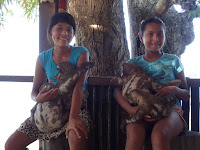I decided to write this blog because over the past year I have fallen in love with these little creatures and wanted to become more informed. Lately, sloths have gotten a bad rap in movies and on t-shirts, so wanted others to become more informed as well!
There are two main types of sloths, the three-toed, as seen in the above photo, and the two-toed sloth. The three-toed sloths are smaller with the pygmy sloth being the smallest. The two-toed sloths are larger, tend to have slightly fluffier fur, and longer noses.
Defense:
The claws! One of the greatest assets for a sloth are their claws. They don't only look super cool, but they are what help them cling onto branches and are their main defense mechanism. I once heard a story that a sloth became agitated over a wild dog barking so slit its' throat. It's sad, but it also shows how careful you need to be around them!
 |
Hanging on tight!  |
Handling:
In Columbia we had the wonderful experience of being able to hang out with a baby sloth. While we had a blast, we did learn you have to be careful with the adult sloths. If they have not been raised around human contact, being held can raise their heartbeat, which can become harmful for their health. Some are also much feistier than others so be aware! In the above picture, because the three sloths were raised around humans, they were very comfortable being held.
Habitat:
In the above picture to the left is the baby Colombian sloth climbing back up to his perch in the trees. He was originally found in a papaya tree by the owner who was getting the fruit for our morning snack. The sloth on the right is a little guy from Costa Rica who put a on a show for us by climbing down the mangroves to take an afternoon drink! You will often see sloths closer to the water as they are better swimmers (the breaststroke I've read:-) than walkers due to their front arms being stronger than their back thighs. On land their long claws also give them difficulty, making them very slow and leaving them much more vulnerable to attack by other predators.
From the picture on the above right you can also notice the hints of green in the fur. This is algae that grows on them due to their slow nature. As they live in the high branches of trees for most of their life, it actually acts as an extra element of camouflage to protect against preying vultures and predators.
Breeding:
Above are two little babies, the one from Colombia and the other we saw in Bocas del Toro behind the Smithsonian's fence. They are both probably a little older than six months old which is when the mother will start to leave them. A mother can only give birth to one sloth and the pregnancy is usually between 5-6 months for the three-toed sloth and as long as 11.5 for the larger two-toed sloths. While I couldn't see for sure, I believe the sloth on the right was a two toed-sloth. The fur is a little fluffier and the nose a little longer.
To wrap things up, a few fun facts about these funny little creatures!
- sloths only have 25% muscle in their bodies so they are unable to shiver
- they can climb at the rate of about 6-8 feet per minute
- their stomach consists of four compartments and it can take up to a month to digest one leafy meal
- both mating and giving birth happens in the trees
- sloths only sleep about nine hours a day
- they are not social creatures
- according to the San Diego Zoo one species of sloth could initially grow up to the size of an elephant but they became extinct about 10,000 years ago
*All photographs were personally taken in Colombia, Panama, and Costa Rica*
*** To view more about RnD check out our other social media sites***
Instagram - rndhospitality
Twitter - @rndhospitality
Facebook - RnD Hospitality Group
www.rndhospitalitygroup.com







No comments:
Post a Comment